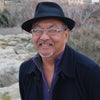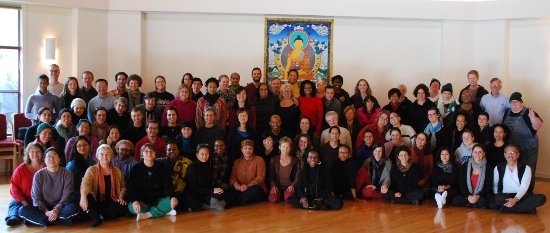Toward a Multicultural Buddhist Practice
"Sangha" is the word from the Pali language (the first language in which the Buddha's Teachings were written) which means "community," and specifically, a spiritual community of like-minded and like-hearted people. While it might seem like a no-brainer, it is important to remember that the Sangha or community is always about Culture.
In previous segments of this series, the Refuge of the Buddha's words and the historical unfolding of the Dharma were shown to be integrally woven to the experience of Culture. Cultural dynamics of conflict and resistance, integration and synthesis, evolution and transformation -- are all part of how the Dharma develops and how the Dharma is lived into future generations of human experience. Our current situation in North America is no exception. Culture is one of the doors through which the Buddha's Teachings are being transmitted into the diverse communities of the West. This is one of the primary reasons that culturally specific, or identity-focused support, like retreats for communities of color or LGBT communities or young people or women, are so important.
Before the large Euro-American mainstream-culture sanghas were formed in the U.S., there had emerged (since the 1800s) many Asian temples and spiritual centers within which to practice -- Chinese, Japanese, Tibetan, Thai, Burmese, Cambodian and Vietnamese, among others. Over time, especially by the middle portion of the last century, many westerners of Euro-American descent had gone to Asian cultures and returned with their experience in the Dharma and what they had learned. Many of these individuals have since become our senior western meditation teachers. An interesting reflection is why Euro-Americans returning from Asia in the 1970s and '80s did not practice and teach in the existing temples that had already been created over the previous 100+ years? Why did Euro-American practitioners feel the need to form their own communities and retreats in spite of existing Asian practice venues?
I suspect that some of the reasons, without the intention to over-generalize, are because these emerging western teachers realized that Euro-Americans would not necessarily see themselves reflected within those Asian spiritual centers and communities. Euro-Americans would not see their life stories mirrored in the way the teachings were languaged within Asian cultural norms and values. They would not experience how the Dharma was relevant to the conditions of their particularly western cultural lives. So, Euro-American practitioners created communities (sanghas) centered around the experiences of Euro-Americans, totally understandably, because culture is a doorway into the teachings. Culture allows the teachings to become relevant to a specific community. Culture begins to connect-the-dots and show people that "yes, this practice is for me too -- not just for others." The reasons that Euro-Americans chose to form their own sanghas, are the exact same reasons that people of color (POC) and LGBT/queer communities also need to create culturally relevant sanghas for themselves.
Indeed, regardless of our cultural differences, we are the same ... in that we respond in the same way to many of the same cultural circumstances (even if the specific cultural details or story lines differ). This is a piece of our interconnectedness and our universality. We all (not just people of color or LGBT communities, but also mainstream Euro-Americans) need to create sanghas based on culture and identity -- because we are all human. We all have a need for safety and community, especially in the beginning of our practice. It is always helpful to see ourselves reflected in the teachings, reflected in the teachers who teach, reflected in the spiritual environment around us. To deny that to any cultural group who feels the need for it, is an act of cultural unconsciousness.
Of course, the intention of creating culturally specific practice venues, like POC and LGBT retreats, is not to be the final goal of practice, but merely a skillful means to create access and safety for communities who feel that they don't belong to or relate to mainstream cultural environments of the Dharma. Even though a mainstream sangha might have the intention to be totally inclusive, unless a refined attention to culture and diversity permeates that sangha's experience, the outcome will fall short of the aspiration.
This deep inclusivity is yet-to-be-achieved in part due to our collective cultural unconsciousness, which includes the legacy of racism, homophobia and oppressions of many sorts. But as C.G. Jung coined the term "collective unconscious," this implies that a "collective consciousness" is possible. Our collective practice of awareness can elevate our communities so that the aspiration of Dr. Martin Luther King Jr.'s "Beloved Community" is possible. Eventually, the Dharma invites the deepest intention from all communities -- Euro-American, communities of color, queer folks, young people, people of different physical abilities -- to be able to practice anywhere, with anyone, under any circumstance; to be able to practice together as a gathering of Whole Communities.* That intention will take a concerted effort from all of us to raise the level of our personal and collective awareness in how to live together with both intentions and actions of non-harm, non-oppression and non-exclusion.
And it takes time -- it takes a lot more time than anyone would like. In 2010, Spirit Rock Meditation Center created the opportunity for a multicultural gathering to practice over the Martin Luther King Jr. weekend. Out of 90 participants, 50 percent were from communities of color and 50 percent were from Euro-American communities. It was a weaving of difference, commonality, connection and diversity. And it was more than 20 years in the making (that is another story). It took that much time to begin transforming practitioners, teachers, board members, management, staff and the organization itself, toward a multicultural awareness that could allow such an event, whose fabric had diversity woven into it, to thrive. The "bad news" is that it could not have been done any sooner (or else it would have!). The conditions were not available in the cultural awareness of the community landscape of how to be authentically together in spiritual practice. The "good news" is that it was done. And in 2012 it was done again, with the deep knowing that it is so rare and precious, anywhere in this world, to be able to gather such diverse communities together in deep spiritual intention, and that it is a profound responsibility to continue the efforts.
2010 Martin Luther King weekend retreat at Spirit Rock Meditation Center
Creating Whole and Beloved Communities does not arise just because we want them to, or because we think we deserve them, or because we think that this is the way things should be, nor does it happen overnight. It happens through the diligence and consistency of difficult work, constant compassion, and always our highest intentions embodied by Wise Effort and the entire Eightfold Path (the umbrella of the Buddha's Teachings) from all communities, to work on ourselves over time, so that we then can work on ourselves together.
In creating practice opportunities both for culturally specific populations and for the larger community to gather in cultural mindfulness and awareness of our humanity, we can be invited from the question "Who am I?" into the larger explorations of "Who are WE?" "Who are WE in this Life?" and "Who are WE really?" What kind of path toward collective liberation is possible? The Buddha said that he would not teach that which is not possible or that which we cannot do.
In our spiritual journeys, we all have that need for safety and feeling at ease in order to deeply explore our places of healing, our places of injury, our joys and our sorrows. That place is vulnerable and tender. And just as we are so much more than who we think we are as individuals, we are also so much more than who we think we are as communities. As we enlarge our spiritual capacity to be with all of our experience, we also gain the capacity to be with the all of the experience of greater and greater numbers of beings. This is the invitation of the Dharma into the Unconditional, into the expansiveness that is the community and sangha, into the vast connections we have as the Universal Family.
This is why the Sangha is about Culture.
And this is also why the Buddha, Dharma and Sangha are all so much about Culture.
*Gratitude to the Center for Whole Communities in Waitsfield, Vermont for introducing me to the terminology of "Whole Communities."


